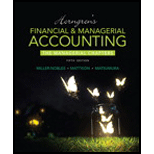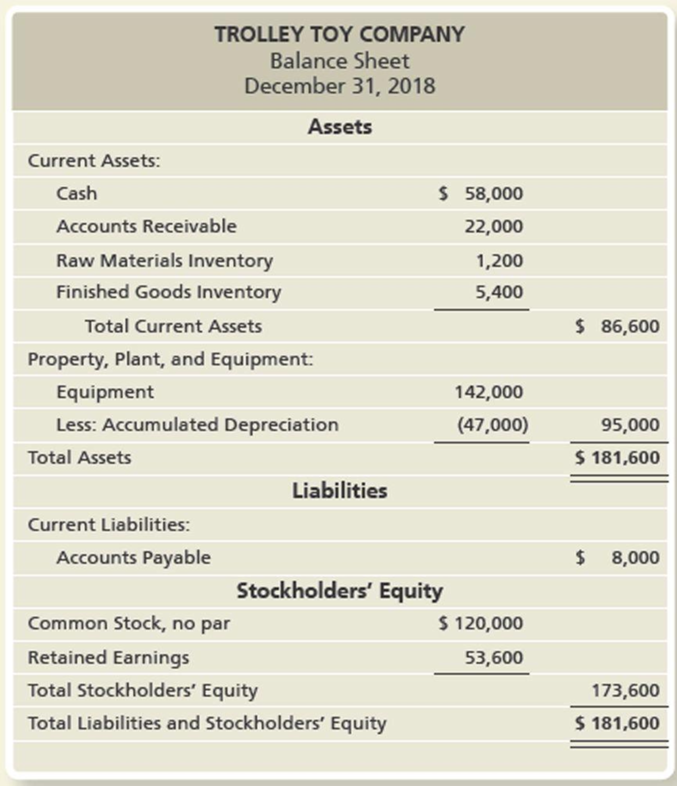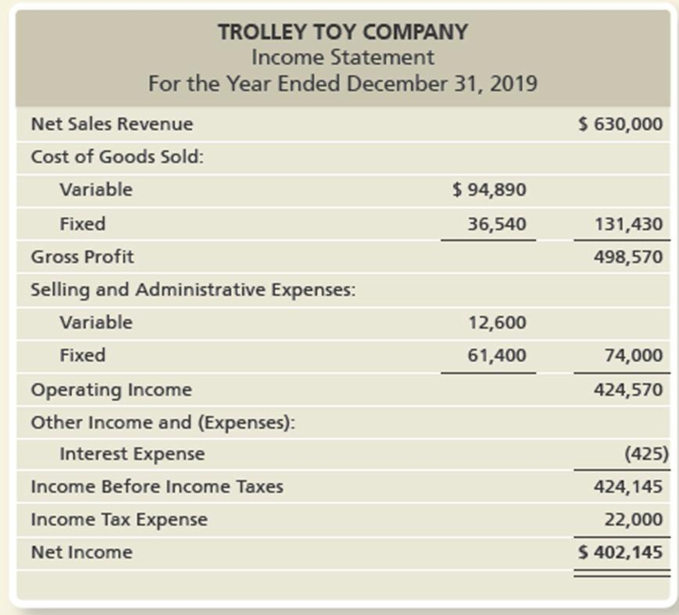
Concept explainers
The Trolley Toy Company manufactures toy building block sets for children. Trolley is planning for 2019 by developing a

Other budget data for Trolley Toy Company:
- a. Budgeted sales are 1,400 sets for the first quarter and expected to increase by 150 sets per quarter. Cash sales are expected to be 30% of total sales, with the remaining 70% of sales on account. Sets are budgeted to sell for $90 per set.
- b. Finished Goods Inventory on December 31, 2018, consists of 200 sets at $27 each.
- c. Desired ending Finished Goods Inventory is 40% of the next quarter’s sales; first quarter sales for 2020 are expected to be 2,000 sets. FIFO inventory costing method is used.
- d. Raw Materials Inventory on December 31, 2018, consists of 600 pounds. Direct materials requirement is 3 pounds per set. The cost is $2 per pound.
- e. Desired ending Raw Materials Inventory is 10% of the next quarter’s direct materials needed for production; desired ending inventory for December 31, 2019, is 600 pounds; indirect materials are insignificant and not considered for budgeting purposes.
- f. Each set requires 0.30 hours of direct labor; direct labor costs average $12 per hour.
- g. Variable manufacturing overhead is $3.60 per set.
- h. Fixed manufacturing overhead includes $7,000 per quarter in depreciation and $2,585 per quarter for other costs, such as utilities, insurance, and property taxes.
- i. Fixed selling and administrative expenses include $11,000 per quarter for salaries; $1,500 per quarter for rent; $1,350 per quarter for insurance; and $1,500 per quarter for depreciation.
- j. Variable selling and administrative expenses include supplies at 2% of sales.
- k. Capital expenditures include $45,000 for new manufacturing equipment, to be purchased and paid for in the first quarter.
- l. Cash receipts for sales on account are 40% in the quarter of the sale and 60% in the quarter following the sale;
Accounts Receivable balance on December 31, 2018, is expected to be received in the first quarter of 2019; uncollectible accounts are considered insignificant and not considered for budgeting purposes. - m. Direct materials purchases are paid 90% in the quarter purchased and 10% in the following quarter; Accounts Payable balance on December 31, 2018, is expected to be paid in the first quarter of 2019.
- n. Direct labor, manufacturing overhead, and selling and administrative costs are paid in the quarter incurred.
- o. Income tax expense is projected at $3,500 per quarter and is paid in the quarter incurred.
- p. Trolley desires to maintain a minimum cash balance of $55,000 and borrows from the local bank as needed in increments of $1,000 at the beginning of the quarter; principal repayments are made at the beginning of the quarter when excess funds are available and in increments of $1,000; interest is 10% per year and paid at the beginning of the quarter based on the amount outstanding from the previous quarter.
Requirements
- 1. Prepare Trolley’s operating budget and cash budget for 2019 by quarter. Required schedules and budgets include: sales budget, production budget, direct materials budget, direct labor budget, manufacturing overhead budget, cost of goods sold budget, selling and administrative expense budget, schedule of cash receipts, schedule of cash payments, and cash budget.
Manufacturing overhead costs are allocated based on direct labor hours. - 2. Prepare Trolley’s annual financial budget for 2019, including
budgeted income statement and budgeted balance sheet. - 3. Trolley sold 7,000 sets in 2019, and its actual operating income was as follows:

Prepare a flexible budget performance report through operating income for 2019. Show product costs separately from selling and administrative costs. To simplify the calculations due to sets in beginning inventory having a different cost than those produced and sold in 2019, assume the following product costs:

- 4. What was the effect on Trolley’s operating income of selling 500 sets more than the static budget level of sales?
- 5. What is Trolley’s static
budget variance for operating income? - 6. Explain why the flexible budget performance report provides more useful information to Trolley’s managers than the static budget performance report. What insights can Trolley’s managers draw from this performance report?
- 7. During 2019, Trolley recorded the following cost data:


Compute the cost and efficiency variances for direct materials and direct labor.
- 8. For manufacturing overhead, compute the variable overhead cost and efficiency variances and the fixed overhead cost and volume variances.
- 9. Prepare the
standard cost income statement for 2019. - 10. Calculate Trolley’s ROI for 2019. To calculate average total assets, use the December 31, 2018, balance sheet for the beginning balance and the budgeted balance sheet for December 31, 2019, for the ending balance. Round all of your answers to four decimal places.
- 11. Calculate Trolley’s profit margin ratio for 2019. Interpret your results.
- 12. Calculate Trolley’s asset turnover ratio for 2019. Interpret your results.
- 13. Use the expanded ROI formula to confirm your results from Requirement 10. Interpret your results.
- 14. Trolley’s management has specified a 30% target
rate of return . Calculate Trolley’s RI for 2019. Interpret your results.
Want to see the full answer?
Check out a sample textbook solution
Chapter 24 Solutions
Horngren's Financial & Managerial Accounting, The Managerial Chapters (6th Edition)
Additional Business Textbook Solutions
Operations Management
Accounting Information Systems (14th Edition)
Managerial Accounting (5th Edition)
Financial Accounting (12th Edition) (What's New in Accounting)
Corporate Finance (4th Edition) (Pearson Series in Finance) - Standalone book
Horngren's Accounting (12th Edition)
- A company uses the weighted-average method for inventory costing. At the end of the period, 21,000 units were in the ending Work in Process inventory and are 100% complete for materials and 66% complete for conversion. The equivalent costs per unit are; materials, $2.56, and conversion $2.25. Compute the cost that would be assigned to the ending Work in Process inventory for the period. a. $84,945. b. $169,260. c. $75,680. d. $129,990. e. $111,712.arrow_forwardKindly help me with accounting questionsarrow_forwardPlease provide answer this general accounting questionarrow_forward
- Please given correct answer general accountingarrow_forwardAs of December 31, 2018, Blossom Company has assets of $41,800 and stockholders' equity of $20,400. What are the liabilities for Blossom Company as of December 31, 2018? A. $20,400. B. $41,800. C. $62,200. D. $21,400.arrow_forwardKenney Co. uses process costing to account for the production of canned energy drinks. Direct materials are added at the beginning of the process and conversion costs are incurred uniformly throughout the process. Equivalent units have been calculated to be 19,200 units for materials and 16,000 units for conversion costs. Beginning inventory consisted of $11,200 in materials and $6,400 in conversion costs. April costs were $57,600 for materials and $64,000 for conversion costs. The ending inventory still in process was 6,400 units (100% complete for materials, 50% for conversion). The cost per equivalent unit for materials using the weighted average method would be: a. $0.9167 b. $3.0000 c. $3.5833 d. $7.2500arrow_forward
- General accountingarrow_forwardDon't use ai given answer accounting questionsarrow_forwardThe difference between the actual fixed manufacturing overhead cost and the budgeted fixed manufacturing overhead cost is the: a. fixed overhead spending variance. b. fixed overhead volume variance. c. fixed overhead rate variance. d. fixed overhead efficiency variance.arrow_forward
 Fundamentals Of Financial Management, Concise Edi...FinanceISBN:9781337902571Author:Eugene F. Brigham, Joel F. HoustonPublisher:Cengage Learning
Fundamentals Of Financial Management, Concise Edi...FinanceISBN:9781337902571Author:Eugene F. Brigham, Joel F. HoustonPublisher:Cengage Learning EBK CONTEMPORARY FINANCIAL MANAGEMENTFinanceISBN:9781337514835Author:MOYERPublisher:CENGAGE LEARNING - CONSIGNMENT
EBK CONTEMPORARY FINANCIAL MANAGEMENTFinanceISBN:9781337514835Author:MOYERPublisher:CENGAGE LEARNING - CONSIGNMENT Excel Applications for Accounting PrinciplesAccountingISBN:9781111581565Author:Gaylord N. SmithPublisher:Cengage Learning
Excel Applications for Accounting PrinciplesAccountingISBN:9781111581565Author:Gaylord N. SmithPublisher:Cengage Learning Principles of Cost AccountingAccountingISBN:9781305087408Author:Edward J. Vanderbeck, Maria R. MitchellPublisher:Cengage Learning
Principles of Cost AccountingAccountingISBN:9781305087408Author:Edward J. Vanderbeck, Maria R. MitchellPublisher:Cengage Learning Cornerstones of Cost Management (Cornerstones Ser...AccountingISBN:9781305970663Author:Don R. Hansen, Maryanne M. MowenPublisher:Cengage Learning
Cornerstones of Cost Management (Cornerstones Ser...AccountingISBN:9781305970663Author:Don R. Hansen, Maryanne M. MowenPublisher:Cengage Learning Managerial AccountingAccountingISBN:9781337912020Author:Carl Warren, Ph.d. Cma William B. TaylerPublisher:South-Western College Pub
Managerial AccountingAccountingISBN:9781337912020Author:Carl Warren, Ph.d. Cma William B. TaylerPublisher:South-Western College Pub





